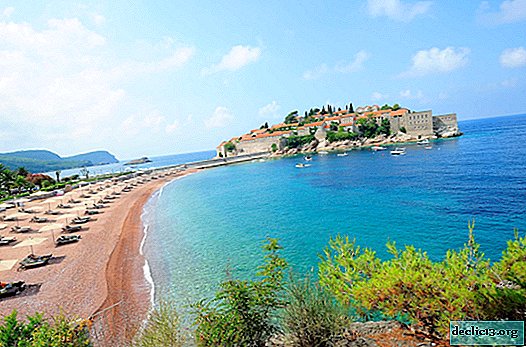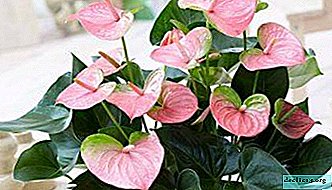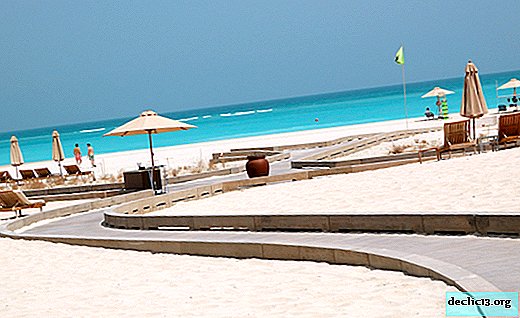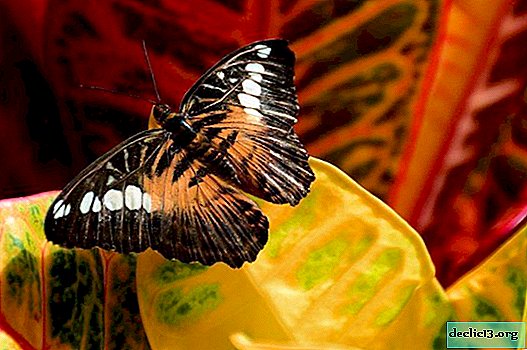Topkapi Palace - the most visited museum in Istanbul
Topkapi Palace is a unique architectural monument of Istanbul, which has more than 5 centuries. The historical complex is located on the picturesque cape Sarayburnu (translated from Turkish as "palace cape"), in the place where the famous Bosphorus Strait connects to the Sea of Marmara. Once the main residence of the Ottoman rulers today is transformed into a museum, which is one of the top most visited attractions of the metropolis.

Topkapi Palace in Istanbul covers an incredible area of 700 thousand square meters. meters, making it one of the largest museums in the world. The complex includes four courtyards, each of which has its own unique attractions. Because of its sheer scale, the palace is often called a separate city within Istanbul.

At least 65 thousand exhibits are presented in the castle halls, which is only a tenth of the total palace collection. And the decoration of the museum is replete with skillful mosaics, murals, marble and elements of gold. If you still cannot decide to visit this place, we present to you our detailed article on Topkapi Palace in Istanbul with a photo and description that will completely dispel all your doubts.
Short story
 Mehmed the Conqueror
Mehmed the ConquerorTopkapi began to erect the Sultan's Palace in 1463 under the rule of Mehmed the Conqueror - the illustrious Ottoman padishah, who managed to subdue the impregnable Constantinople. Cape Sarayburnu served as a place for a future noble residence, where the Byzantine imperial castle once stood, but by the 15th century it was practically destroyed, and only the church of St. Irina remained from it.
Initially, the palace was used by the sultans to hold official meetings and receive foreign guests. Women and children did not live in the residence at that time. But already in the 16th century during the reign of Suleiman I the Magnificent, the castle underwent great changes. At the request of his wife Roksolana (Alexandra Anastasia Lisowska), who wanted to live as close to her husband as possible, the padishah gave the order to transfer the harem to the Topkapi Palace.

Until the mid-19th century, the building served as the official seat of the Ottoman rulers. Everything changed in 1842, when Sultan Abdul Merzhid I, dejected by the medieval interiors of Topkapi, ordered to build a new baroque castle that could compete with eminent European palaces. The new residence was called Dolmabahce, its construction was completed in 1853, and it was then that Topkapi lost its former significance.
After the fall of the Ottoman Empire, the President of the Republic of Turkey, Ataturk, assigned Topkapi the status of a museum (1924). And today, about 2 million tourists visit this historic complex every year, making it the most popular attraction in Istanbul and the second most visited museum in Turkey (1st place at the Mevlana Museum in Konya).
Palace structure
From the photo of the Topkapi Palace in Istanbul, it is difficult to understand how large-scale this building is: after all, the castle consists of four large courtyards, each of which has its own iconic objects.
 Yard No. 1
Yard No. 1This is the largest section of the four, called the Janissaries Courtyard. One of the most noteworthy sights of this part of the castle is the Imperial Gate, through which the great Turkish sultans once entered the residence. And it was from here that the Ottoman padishahs went out on Friday prayers in Aya Sofya (read more about the cathedral here.). Today, any traveler has the opportunity to go through the once noble gates. Their doors are completely made of marble, and the facade is decorated with golden inscriptions in Arabic.

Here the sultans held various festivities, and also held Friday prayer ceremonies. Interestingly, only this part of the palace was open to other visitors: the audience of the padishah was expected by foreign ambassadors and senior government officials. And especially important guests were even allowed to ride inside on horseback.
 Church of St. Irina
Church of St. IrinaAnother notable object was the church of St. Irina 532, which is considered one of the first Christian churches that have survived to this day. After the Ottomans captured Constantinople, they did not begin to destroy the shrine, but turned it into a warehouse for weapons. In the following centuries, the church managed to visit the archaeological, imperial and military museum, but as a result, all the exhibits were taken out of it, and scientists had the opportunity to conduct a full-fledged study of the Byzantine basilica and reveal its great historical value. Today the temple serves as a concert venue.
Yard No. 2The second courtyard welcomes guests of the palace with the gates of Salutation, built in the classical Ottoman style, decorated with an arched vault and two European-style towers. Above the arch are black panels with gilded inscriptions in Arabic. The Salutation Gate leads to the central part of the complex and today acts as the main entrance to the palace for tourists.

Going inside, the traveler will immediately pay attention to the Council Building with the Tower of Justice towering above it. Under the rule of Suleiman I, the chamber was transformed from a simple wooden building into a structure decorated with columns, arches, gilded gratings and bas-reliefs. Viziers took part in the meeting of the Divan, but the Ottoman padish himself was absent in the hall. The Sultan followed the advice from the Tower of Justice, and if he did not agree with the decision of the officials, he closed the window, thereby interrupting the meeting and convening all the ministers.

It is also worth paying attention to the eight-domed building of the External Treasury, which functioned until the mid-19th century. Today it serves as a gallery where various types of weapons are exhibited. In addition, in this part of Topkapi there are buildings for the court servants, stables of the Sultan, a hamam and a mosque.

Palace kitchens of incredible size, including 10 sections, where dishes were prepared not only for the Sultan and the inhabitants of the harem, but also for high-ranking officials deserve special attention. Today, in the walls of the former kitchen, household items and utensils of palace cooks and dishes, in which dishes were served to the sultans and other nobles, were put on display by visitors.

In the same part of the castle is the entrance to the famous Sultan's harem, which today has turned into a separate museum. Once the harem consisted of four sections: the first was assigned to the eunuchs, the second to the concubines, the third to the mother of the padishah, and the fourth to the Turkish ruler himself. In total, there are up to 300 rooms, there are several baths, 2 mosques and a women's hospital. Many rooms are quite small and simple in the interior, which cannot be said about the famous chambers of Alexandra Anastasia Lisowska in the Topkapi Palace in Istanbul, photos of which annually attract hundreds of thousands of tourists to places of interest.
In the third section of the castle are the gates of Happiness, or, as they are often called, the Gates of Bliss, built in the Ottoman Baroque style and decorated with a wooden dome and four marble columns. The passage opens the door to the inner courtyard of the complex, where the former private rooms of the padishah are located. Only the sultan could pass through this gate, and if someone tried to get inside without permission, such an act was regarded as treason to the sovereign. The gates were strictly guarded by the chief eunuch and his subordinates.

Immediately after the gates of Happiness is the Throne Hall, where the Sultan conducted his state affairs and received foreign ambassadors. It is noteworthy that the building has two doors at once: one was intended exclusively for the padishah, the second - for all other visitors. The decoration of the building includes a variety of patterns in the form of flowers, trim in gems, marble columns and gilded lattices.
In the very center of the third courtyard is the Library, which was intended for students of the palace school. This picturesque building is surrounded by fountains and verdant miniature gardens, crowned with a domed roof, arched openings with marble columns. And ceramics dominate in its interior. Today, the Library exhibits books from personal collections of eminent sultans.

Also, from the structures of the third section, it is worth mentioning separately the Treasury, which is considered one of the oldest buildings in Topkapi, the Treasure Chamber, which was once responsible for the safety of all the jewelry of the Sultan, and the Secret Pavilion, which was the personal mansion of the Turkish rulers. One can also note the largest palace mosque, Agalar, where the padishas came to pray with their pages and squires.
Yard No. 4It is from here that the most picturesque landscapes in the castle can be seen, so this is an ideal place for photos in the Topkapi Palace. Here is the Tulip Garden, a place where the Sultans loved to retire and plunge into their thoughts. The garden is full of bright colors from fragrant flowers, fruit trees and vineyards. Nearby lies the Marble Terrace, which offers an incredible panorama of the Bosphorus and the Sea of Marmara, as well as the Golden Horn. Read about other places of the city with panoramic views in this article.

Among the notable objects of this part, the Yerevan and Baghdad pavilions, the Hall of Columns, the Circumcision Pavilion and the Mosque of Sofa stand out. All buildings have been preserved in good condition, and their interior, represented by the classical Ottoman style, once again emphasizes the skill of Turkish architects.

Practical information
If you are looking for information on where the Topkapi Palace in Istanbul is located, we inform you of it the exact address: Cankurtaran Mh., 34122 Fatih / İstanbul.
Working hours: The museum is open daily except Tuesdays. In the winter season, from October 30 to April 15, the institution operates on a shortened schedule from 09:00 to 16:45. You can buy tickets until 16:00. In the summer, from April 15 to October 30, the palace is available from 09:00 to 18:45. Ticket offices are open until 18:00.

Cost: as of September 2018, the entry price to the Topkapi Museum is 40 tl. To visit the harem, you must purchase an additional ticket worth 25 tl. Entrance to the church of St. Irina is also paid separately - 20 tl per person. We draw your attention to the fact that from October 1, 2018, Turkish officials raise prices for entrance tickets to more than fifty museums. Entrance to Topkapi will also rise in price and amount to 60 tl.
Official site: topkapisarayi.gov.tr/en/visit-information.
Read also: Turkish national dishes - what to try in Istanbul.Find out RATES or book any accommodation using this form
Visiting Rules

It is worth considering that on the territory of the historical complex there are religious institutions that impose special requirements on the appearance of visitors. So, for women on a tour of Topkapi, it is best to refuse frankly short shorts and skirts, too tops and blouses. Men in t-shirts and beach shorts are not welcome.
Taking photos at the Topkapi Palace in Istanbul is generally not prohibited, although there are exceptions. So, in the exhibition halls, photography of collections is strictly prohibited. The order is carefully monitored by security guards who, noticing that you have violated the rules, will immediately require you to delete all the pictures.
It is also important to know that it is forbidden to enter the territory of the palace with wheelchairs. Well, of course, it is worth observing the elementary rules of decency: do not laugh out loud, do not walk around the halls with food and drinks, respect the staff and other visitors.
Compare accommodation prices using this form
Useful Tips
In order for your tour of the Topkapi Palace in Turkey to be as positive as possible, you should pay attention to the recommendations of tourists who have already visited the place. After studying the reviews of travelers, we have collected only the most practical tips for visiting the museum:

- Before heading to Topkapi, be sure to find information about whether restoration work is underway in it. And if they are conducted, then postpone your trip to the museum, otherwise you risk deleting a good half of its sights from your excursion.
- Being the most visited place in Istanbul, the palace attracts thousands of tourists every day, which creates huge queues at the box office. Therefore, it is best to come to Topkapi early in the morning, before opening.
- Near the ticket office there are vending machines where you can buy entrance tickets with a bank card.
- If the palace complex is not the only museum that you are going to see in Istanbul, then it is logical to purchase a special pass valid for 5 days only in the institutions of the metropolis. Its cost is 125 tl. Besides the fact that such a card will save you a little money, you will also save yourself from long waiting in lines.
- The most interesting thing is to study the halls of the complex in the company of an audio guide. Its price is 20 tl. We also recommend that you additionally read information about Topkapi Palace in order to understand where you go and what you look at.
- In order to fully observe all the sights of the museum, it will take at least 2 hours.
- Be sure to bring bottled water with you. In the complex, a bottle of water costs 14 tl when, as in a simple store, you pay a maximum of 1 tl for it.
- Within the walls of the palace there are several restaurants and souvenir shops, but the prices are very high. And if your plans do not include unnecessary expenses, then it is better not to go there.

Output
Topkapi Palace is the national pride of Turkey, and today the country's authorities are making a lot of efforts to maintain the museum complex in perfect condition. Of course, restoration work can be a real disappointment for an inquisitive traveler, so it is very important to choose the right time to visit the site.
Video: what the territory and interior of Topkapi Palace looks like.

















